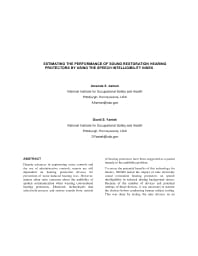Mining Publication: Estimating the Performance of Sound Restoration Hearing Protectors using the Speech Intelligibility Index
Original creation date: November 2010
Authors: AS Azman, DS Yantek
NIOSHTIC2 Number: 20038266
Proceedings of the ASME 2010 International Mechanical Engineering Congress & Exposition IMECE2010 November 12-18, 2010, Vancouver, British Columbia, Canada. New York: The American Society of Mechanical Engineers, IMECE2010-37736, 2010 Nov; :1-9
Despite advances in engineering noise controls and the use of administrative controls, miners are still dependent on hearing protection devices for prevention of noise-induced hearing loss. However, miners often raise concerns about the audibility of spoken communication when wearing conventional hearing protectors. Electronic technologies that selectively process and restore sounds from outside of hearing protectors have been suggested as a partial remedy to the audibility problem. To assess the potential benefits of this technology for miners, NIOSH tested the impact of nine electronic sound restoration hearing protectors on speech intelligibility in selected mining background noises. Because of the number of devices and potential settings of those devices, it was necessary to narrow the choices before conducting human subject testing. This was done by testing the nine devices on an acoustic test fixture (ATF) to acquire one-third-octave band data, and then calculating the speech intelligibility index (SII) to determine estimates of performance across device, noise and setting. The estimates of speech intelligibility obtained with the SII are highly correlated with the intelligibility of speech under adverse listening conditions such as noise, reverberation, and filtering. The results of fixture based testing indicate that performance varies little between most devices, with few showing exceptionally good or poor estimated speech intelligibility. The most significant differences in estimated performance using the devices were between the different noise sources used, regardless of device or setting. The findings of this research were used to select the devices and settings for subsequent human subject based speech intelligibility testing. The human subject testing results largely concurred with the findings from the acoustic test fixture testing and calculation of speech intelligibility index. Specifically, variations in background noise led to the greatest differences in speech intelligibility.

NIOSHTIC2 Number: 20038266
Proceedings of the ASME 2010 International Mechanical Engineering Congress & Exposition IMECE2010 November 12-18, 2010, Vancouver, British Columbia, Canada. New York: The American Society of Mechanical Engineers, IMECE2010-37736, 2010 Nov; :1-9
- Analysis of Acoustic Responses of Domal Salt Mine Samples
- A Comparison of Beamforming Processing Techniques for Low Frequency Noise Source Identification in Mining Equipment
- Cross-Sectional Survey of Noise Exposure in the Mining Industry
- An Examination of Antecedents to Coal Miners' Hearing Protection Behaviors: A Test of the Theory of Planned Behavior
- Noise and Hearing Protection: Development of Two Training Exercises for Drillers
- Noise Source Identification on a Horizontal Vibrating Screen
- Passive Fiber Optic System for Locating, Tracking, and Communicating with Personnel in Coal Mines
- Sound Restoration Hearing Protection: Genesis of a Standard Test Method
- Using Persuasive Messages to Encourage Voluntary Hearing Protection Among Coal Miners
- Wearing Hearing Protection Properly: A 3-D Training Aid for Drillers